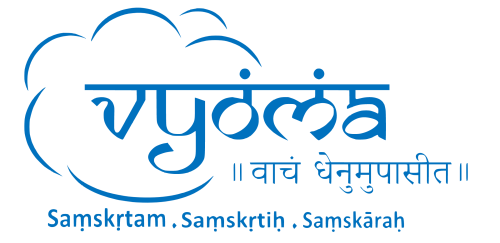गुरु बिन ज्ञान न उपजै, गुरु बिन मिलै न मोक्ष ।
गुरु बिन लखे न सत्य को, गुरु बिन मिटे न दोष ॥
guru bina jñāna na upajai, guru bina milai na mokṣa ।
guru bina lakhe na satya ko, guru bina miṭe na doṣa ॥
Without a guru, knowledge cannot arise; without a guru, liberation cannot be attained. Without a guru, truth cannot be perceived, and without a guru, flaws cannot be eradicated.
The importance of a guru is beautifully captured in the above dohā (couplet) of Santa Kabir. Guru-śiṣya-paramparā is an ancient Indian tradition where students deeply respect and revere their teachers, considering them as equivalent to God.
गुशब्दस्त्वन्धकारः स्यात् रुशब्दस्तन्निरोधकः ।
अन्धकारनिरोधित्वात् गुरुरित्यभिधीयते ॥
– गुरुगीता १.३४
guśabdastvandhakāraḥ syāt ruśabdastannirodhakaḥ।
andhakāranirodhitvāt gururityabhidhīyate॥
– Gurugītā 1.34
The syllable ‘gu’ stands for darkness of ignorance and the syllable ‘ru’ denotes the one who removes it. Because of the ability to destroy the darkness of ignorance, one is called a Guru.
It is commanded by the Upaniṣad-s, “आचार्यदेवो भव – Be the one who reveres the Ācārya as God”. (Taittirīya Upaniṣad, śikṣāvallī – I:11:2). The guru–śiṣya relationship became a key part in Indian culture as knowledge is passed down through successive generations.
Gratitude towards the guru-s
Though worshipping and serving the Guru is a nitya-kartavya, an act to be performed daily and consistently, Guru-pūrṇimā is an occasion which provides us an opportunity to
- Contemplate the greatness of our lineage of Guru-s.
- Understand their phenomenal contribution to Sanātana Dharma.
- Reaffirm our commitment to the adhyayana and pracāra of knowledge which we have received from these Guru-s.
Guru-Pūrṇimā is also known as Vyāsa-pūrṇimā. This is celebrated on Āṣāḍha Pūrṇimā in reverence of Vyāsa, the author of the Mahābhārata.
Vyāsa, the foremost Guru of Sanātana Bhārata
Vyāsa’s contributions to Sanātana Dharma are immense. We can look at these in four broad sections.
1) Vedas – Earlier, the veda was a single, undivided mass of knowledge. Vyāsa divided and organised the Veda-s into four parts as Ṛk, Yajus, Sāma & Atharva, and assigned each part to one disciple to ensure continued propagation. Paila was made the incharge of Ṛgveda, Jaimini of the Sāmaveda, Vaiśaṃpāyana of the Yajurveda and Sumantu of Atharvaveda. By this, Vyāsa ensured the continuity of vedic tradition.
2) Itihāsa and Purāṇa-s – It is said that to understand Veda-s one has to study the Itihāsa and Purāṇa texts, which is said in a well known śloka –
इतिहासपुराणाभ्यां वेदं समुपबृंहयेत् ।
– ब्रह्माण्डपुराणम् – १.७१
itihāsapurāṇābhyāṃ vedaṃ samupabṛṃhayet ।
– brahmāṇḍapurāṇam – 1.71
The Veda-s should be supplemented and enriched by the Itihāsa-s and the Purāṇa-s.
Rāmāyaṇa and Mahābhārata are the two itihāsa-s which form the bedrock of Bhāratīya Saṃskṛti. Among these, the Mahābhārata was authored by Vyāsa. The purāṇa-s are hundreds in number. Among them, it is traditionally accepted that the eighteen major Purāṇa-s were compiled by Vyāsa. Thus, Vyāsa is the most prolific contributor to the genre of Purāṇa-itihāsa-s, which are crucial for understanding veda-s with the right perspective.
3) Philosophical traditions – Most philosophical traditions of Bhārata are based on Prasthāna-trayī (three major source texts), which includes Upaniṣad-s, Bhagavadgītā and Brahmasūtra-s. All different vaidika philosophies including Advaita, Viśiṣṭādvaita, Dvaita, Śuddhādvaita etc. are based on these three (Prasthāna-trayī). Of these, Gītā is a part of Mahābhārata composed by Vyāsa and Brahmasūtra-s were also composed by Vyāsa.
4) Bhakti tradition – Most Vaiṣṇava Bhakti traditions take Vyāsa’s Bhāgavata Mahāpurāṇa as one of the main source texts. Śiva purāṇa is similarly a primary text for Shaivites. Thus, Vyāsa is also revered by the followers of these traditions.
By virtue of all these contributions, Vyāsa is a common Guru for all followers of Sanātana Dharma. So Vyāsa-Pūrṇimā in the month of Āṣāḍha is representative of all Guru-s and celebrated as Guru-pūrṇimā. Without him, the traditional Indian knowledge might not have been preserved and passed down to this generation. Vyāsa’s work ensured that these important texts and teachings were compiled, organised, and shared, allowing the wisdom of ancient India to continue to influence and guide people today.
How is Guru-pūrṇimā pūjā performed in various traditions across Bhārata?
As per the Vrata Paricaya, by Hanumān Śarmā (2006, Gita Press, Gorakhpur, P-87) in some traditions, twelve lines are drawn from east to west and twelve lines from north to south, to create what is called a Vyāsapīṭha. Then, a ritual invocation (āvāhana) of Brahmā, Vyāsa, Śukadeva, Gauḍapāda, Govindasvāmī and Śaṅkarācārya is performed. Following this, a ṣoḍaśopacāra pūjā, which is a ritual with sixteen offerings, is conducted. On the same day, the guru who gave initiation (dīkṣā guru), elders, mother, and father are also worshipped.
In some traditions Pañcaka pūjā is done on the day of Guru-pūrṇimā. It is not that Vyāsa alone is worshipped on Vyāsa-pūjā day, all the preceptors of knowledge in that tradition are also worshipped.
Who all are worshipped in each Pañcaka?
Each Pañcaka group consists of five. Firstly, the prime preceptor (mūla-puruṣa) is worshipped. Then his successors or disciples are worshipped.
Details of the Pañcaka-s are given below according to Yati-Dharma- saṅgraha by Viśveśvara-sarasvatī (1928, Ed. Ganesha Shastri, Anandashram, Pune, P-95)
- Kṛṣṇa-Pañcaka – The first group is called Kṛṣṇa-Pañcaka.
तत्र कृष्णस्य सनत्कुमार-सनक-सनन्दन-सनत्सुजाताः ।
tatra kṛṣṇasya sanatkumāra-sanaka-sanandana-sanatsujātāḥ ।
In the group of Kṛṣṇa there are Sanatkumāra, Sanaka, Sanandana, Sanatsujāta
Along with the Jagadguru (Preceptor of the Universe) Kṛṣṇa above four are worshipped. The Bhāgavata Purāṇa mentions them as being an avatāra of Viṣṇu. They play a significant role in a number of spiritual traditions, especially those associated with the worship of Viṣṇu. They are described as the first mind-born creations and sons of the creator Brahmā.
In some traditions, as part of Kṛṣṇa Pañcaka, Kṛṣṇa, Vāsudeva (Viṣṇu), brother Saṅkarṣaṇa (Balarāma), sons Pradyumna and Aniruddha are worshipped as the deity of mind.
2. Vyāsa-Pañcaka – The second group is called as Vyāsa Pañcaka.
व्यासस्य सुमन्तु-जैमिनि-वैशम्पायन-पैलाः ।
vyāsasya sumantu-jaimini-vaiśampāyana-pailāḥ ।
Vyāsa group consists of Sumantu, Jaimini, Vaiśampāyana and Paila.
The Vyāsa Pañcaka consists of Bhagavān Vyāsa along with his 4 disciples, each dedicated to the dissemination of one veda.
3. Guru-Pañcaka – The third group is called Guru-Pañcaka.
न्यायादाचाराच्च गुरु-परमगुरु-परमेष्ठिगुरु-परात्परगुरवोऽन्ये च ब्रह्मविदाचार्या यथासंनिवेशं भगवतः पुरतः पूज्याः ।
nyāyādācārācca guru-paramaguru-parameṣṭhiguru-parātparaguravo’nye ca brahmavidācāryā yathāsaṃniveśaṃ bhagavataḥ purataḥ pūjyāḥ ।
Justly and according to the sampradāya, Guru, Parama-guru, Parameṣṭhi-guru, Parātpara-guru and other Ācārya-s who are knowers of Brahman should be revered in front of the Bhagavān, as per the proper arrangement.
While performing the Guru pūjā at the end the devotee should worship his/her own guru along with three further generations of the Guru-paraṃparā. All other ācārya-s in the paraṃparā are also worshipped as the fifth component of this pañcaka.
These three Pañcaka-s are seen in most traditions. Among the followers of Ādi Śaṅkarācārya, another pañcaka called Ācārya pañcaka is worshipped, revering Śaṅkarācārya along with his 4 principal disciples.
भाष्यकारस्य पद्मपाद-विश्वरूप-तोटक-हस्तामलकाचार्याः ।
bhāṣyakārasya padmapāda-viśvarūpa-toṭaka-hastāmalakācāryāḥ ।
Bhāṣyakāra group is of Śaṅkarācārya, along with Padmapāda, Viśvarūpa (Sureśvara), Toṭaka and Hastāmalaka ācārya-s
Similarly, in other traditions, important Ācārya-s of that particular paraṃparā are specifically worshipped.
Following table gives a gist of this Pañcaka pūjā
| पञ्चक-नाम | प्रथमः | द्वितीयः | तृतीयः | चतुर्थः | पञ्चमः |
| कृष्ण-पञ्चकम् | कृष्णः | सनत्कुमारः | सनकः | सनन्दनः | सनत्सुजातः |
| व्यास-पञ्चकम् | व्यासः | सुमन्तुः | जैमिनिः | वैशम्पायनः | पैलः |
| गुरु-पञ्चकम् | गुरुः | परमगुरुः | परमेष्ठिगुरुः | परात्परगुरुः | अन्य-आचार्याः |
| भाष्यकार-पञ्चकम् | शङ्कराचार्यः | पद्मपादाचार्यः | सुरेश्वराचार्यः | तोटकाचार्यः | हस्तामलकाचार्यः |
This sacred ritual is dedicated to honoring the Guru, the revered teacher and spiritual guide, whose wisdom and guidance illuminate the path of both material and spiritual learning. By performing Guru-pūjā, we express our heartfelt appreciation for the invaluable knowledge and insight imparted by our guru-s, fostering a deep connection with the timeless traditions that shape our spiritual journey.
गुरु गोविंद दोऊ खड़े, काके लागूं पाय ।
बलिहारी गुरु आपनो, गोविंद दियो बताय ॥
guru goviṃda doū khaḍe, kāke lāgūṃ pāya ।
balihārī guru āpano, goviṃda diyo batāya ॥
When both Guru and God stand before me, to whom should I bow? I bow to my Guru first, for he is the one who showed me the path to God.
Courses offered by Vyoma Linguistic Labs –
Courses/products related to Kṛṣṇa
- Experience Jagadguru Srikrishna (Through Ashtottara Shatanamavali)
- Understanding the Gita – Verse by Verse (English Explanation) Batch – 2
- Repeat & Memorize Bhagavad Gita – Using an Interactive Interface
- Bhagavad Gita – Flipbook to learn 700 shlokas
- Srimad Bhagavadgita – Physical book
Courses related to Vyāsa
- Srimad Bhagavatam Skandha 1 – Simple Verse-by-Verse explanation in Kannada for other Skandha courses, please click here
- Srimad Bhagavatam – Skandha 1(Tamil explanation) for other Skandha courses, please click here
Courses related to Ācārya
8. Learn to chant Sri Shankara Digvijaya Saara
9. Gurutattvam (Discourse in Kannada)


Namaskaram 🙏
My sincere appreciations to Vyoma Labs and all the teachers for compilation of all the information in this article. I am sure a lot of efforts have been put in to find all the required information.
I express my gratitude to Vyoma for your efforts to revive our glorious past.
Wishing you continued success!
Very intersting and useful that avail in proper timing